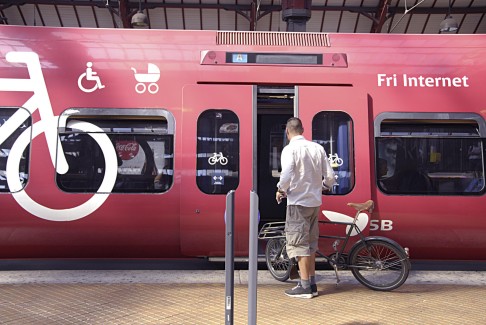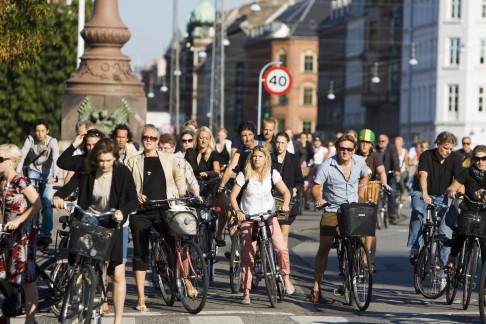
Easy riders
Copenhagen, where the bike takes precedence over the car, could not stand in starker contrast to un-hygge Hong Kong, writes Omar Mouallem
In six days of cycling around Copenhagen, it happens only once.
I've ridden my bike through nine cities - in five countries and on two continents - so I know my place as a cyclist: I'm second class - a status reinforced by hostile drivers and blaring horns.
"You can tell he's not from here," says Kozar, steering to the right to let the driver pass. Sure enough, there is a Hertz sticker on the rear bumper.
Those who live and/or work in Copenhagen seemingly understand and respect the cyclist's right of way; it is enshrined in law and strengthened by separate eye-level traffic lights and blue roundabout bike lanes, 359 kilometres of segregated paths and a bicycle "superhighway" connecting the city with the suburbs.
I can quote other statistics: 52 per cent of Copenhageners commute by bike (many to destinations that are out of town), covering 1.27 million kilometres daily; there are 5.2 bikes in the city for every private car. But the velo's place in the Danish psyche is perhaps best demonstrated by waiter Walter Griese.

At Restaurant Kronborg, a place so old the new management can't date it, I solicit travel tips, between bites of fresh herring and open sandwiches, from Griese, a mild-mannered local. As we sit in antique chairs next to the stone fireplace, he suggests visiting the picturesque Louisiana Museum of Modern Art, in nearby Fredensborg.
"If you're really courageous, bicycle there," he says.
"How far is it?"
"Forty kilometres." I practically choke on my fish. It is simple, he says; "just take the cycle superhighway".
The "superhighway" is a series of paved high-speed (well, high speed for cyclists) tracks to the outskirts of Copenhagen. They were built alongside the regular roads and pass pumping stations as well as petrol stations. The network allows for kilometres of uninterrupted pedalling and I had ventured onto it the morning before for no other reason than to experience it. After 20 minutes, surrounded by fields and trees, I turned back and joined some of the late commuters - suits, formal shoes and all - on their way into the capital.
To get to Fredensborg, I opt, instead, to carry my affordable rental (many hotels offer complimentary bikes to guests) onto the train, which is adorned with enormous two-wheeler decals to welcome people like me.
The museum - the director of which from 1995 to 1998 was Lars Nittve, now executive director of West Kowloon's M+ museum - is the most visited in Denmark, and is noted as a milestone in Danish architecture. It was established in 1958, a time when Danish cities were in danger of losing their strong cycling culture.

After crawling out of depression and the second world war, Danes were eager to embrace symbols of prosperity.
"Because of the development of the welfare state and sharp urbanisation, there was an enormously strong focus on car culture," explains Klaus Bondam, president of the Danish Cyclists' Federation, one of the oldest cycling organisations in the world.
But a tipping point was soon reached in Copenhagen. The medieval city's roads could no longer accommodate the traffic. Pedestrians, and too often children, were being maimed and killed by cars. Something had to be done. Either roads had to be expanded - thereby demolishing historic buildings - or they had to be reclaimed.
"That led to intensive activism and demonstrations in the 1970s, with big bicycle marches and car burnings," Bondam says. "Now the bicycle is a completely integrated part of city life, and in our national culture."
There are other, more complex reasons for the rise of the bicycle. Cars in Denmark are taxed an astronomical 180 per cent, and having one of the lowest income gaps in the developed world has homogenised Danish society. This, Bondam explains, has meant that status is no longer symbolised by material goods, such as expensive cars, but by a healthy physical appearance maintained by an active lifestyle.
"You can, on a regular day in Copenhagen, see the crown prince, taking his twins to kindergarten in a cargo bike."
I do not spot Prince Frederik in Rosenborg Castle, unfortunately. But while we await the changing of the guard to begin, Kozar offers another theory.

"No one's in a hurry in Denmark," he says, as we walk our bikes through the Baroque gardens, along lush rows of perennials and roses, around statues of warriors commissioned by Christian IV in the 17th century. "They have this word, ' ' [pronounced 'hooga']. It means 'relaxed', 'chill'. Working 10 hours a day is not . A glass of wine by the fire is .
"Driving to get around faster is not . A bike is very ."
A hospitality student and bike activist from Budapest, Hungary, Kozar chose to study here because of the cycling infrastructure, for which he has people like Bondam to thank. As deputy mayor in the mid-2000s, Bondam, also a former actor (you may have seen him in Thomas Vinterberg's 1986 movie ), initiated pro-bike policies, such as prioritising the clearing of snow on bike paths before roads. Such policies contributed to Copenhagen becoming the safest place in the world to ride a bike. Only one cyclist died in Copenhagen in 2012 (compared with 10 in Hong Kong, a city where very few people brave the roads on two pedalled wheels).
Copenhagen is now in a race with Amsterdam to become the bike capital of the world, each investing in ever grander parking centres, bridges and lanes for cyclists. Who's winning? I pose the question to Griese, who's experienced both cities.

One Copenhagen oddity is the Christiana bike, which has a cargo trunk on the front. They are everywhere - transporting children, groceries, puppies, hardware and vinyl records. The contraption is truly local, invented and manufactured in Freetown Christiania, a commune with favela-style pavilions and an open marijuana market, aka The Green Light District (no pictures!).
The other oddity "is not very good", Griese says, sheepishly. "The bikers are not very polite."
This we disagree on.
I was in Amsterdam the week before and there I witnessed truly impolite cyclists. The Dutch are far more aggressive. They possess little patience for red lights and pedestrians, or, for that matter, a tourist struggling with his bulky rental. When bikes aren't in use, they are sometimes haphazardly parked beside buildings, crowding pavements and doors.
But Danes seem less menacing. Maybe it's because there are fewer cyclists clogging the paths in the day. Or maybe it's their law-abiding nature (jay-walking is pooh-poohed here) that makes them more predictable riders. Sure, the rush hours, with 50-metre bike queues, are frustrating - I never imagined sitting through two green lights as a cyclist - but it doesn't faze the seasoned locals.
They are, generally speaking, very .
